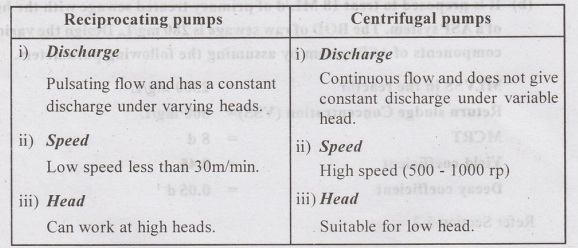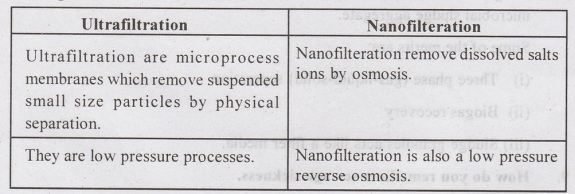Water Supply And Wastewater Engineering: Unit V: Sewage Treatment And Disposal
Model Questions Paper with Answer 2
Water Supply and Wastewater Engineering
Water Supply And Wastewater Engineering: Unit V: Sewage Treatment And Disposal: Model Questions Answer II
MODEL
QUESTION PAPER - II
PART
A
1. Write in brief about recharge of
ground water.
Groundwater recharge (or) deep drainage is a hydrologic process
where water moves downward from surface water to groundwater. Groundwater recharge
is the primary method through which water enters on Aquifer. Ground water
recharge also encompasses water moving away from the water table farther into
the saturated zone.
2. List functions of intake
structures.
The main function of intake is to provide highest quality of
water from source.
To protect pipes and pumps from damaging (or) clogging by wave
action/ floating bodies and submerged aquatic lives.
To help in safely withdrawing water from the source over
predetermined pool levels and then to discharge this water into the withdrawal
conduit.
3. Mention the basic for the
selection of types and capacity of pumps.

4. Write the nature of any four
coagulants.
i) Alum
Most common and universal coagulant. Alum requires presence of
alkalinity in water to form floc. Alum dissolves in water hyderolyze into
aluminium hyderoxide. The aluminium hyderoxide floc so formed in insoluble in
water. Alum reduces turbidity, taste and odour. It produces crystal clear
water.
ii) Chlorinated
Copperas:
Hydrated ferrous sulphate is called copperas. Copperas are
effective in removing colour. Ferric chloride is effective over pH 3.5 to 6.5
and above 8.5.
iii) Ferrous sulphate
and lime:
Lime is added with ferrous sulphate to increase the reaction
rate. The ferric hydroxide is a heavier floc. Ferrous sulphate is effective at
a pH range above 8.5 Agin 000 abiloa babnis
iv) Magnesium
Carbonate and lime
When magnesium carbonate and lime are dissolved in water,
magnessium hyderoxide, Calcium carbonate is formed. Both Mg(OH), and CaCO, are
soluble in water resulting in formation of sludge which is slurry.
5..Distinguish between
Ultrafiltration and Nanofiltration.

6. Mention the the important
components needed for the water distribution to buildings.
i) Valves
a) Sluice valve, b) Check valves, c) Air valves, d) Drain valves
ii) Ferrule
iii) Goose neck
iv) Seevice pipe
v) Stop cock
vi) Water meter
vii) Water taps
7. State the discharge standards
for any two parameters for treated sewage.
Tolerance limit for industrial effluents discharge into public
sewers as per IS 3306-1974
(i) BOD5 -m500 mg/L
(ii) COD - -
(ii) pH value - 5.5 to 9.00
(iv) Total suspended solids - 600 mg/L
(v) Chromium – 2mg/L
8.What do you mean by UASB?
Uplow Anaerobic sludge Blanket: It is an anaerotric reactor in
which sewage flaws upward through the sludge led (or) aggregates. The UASB
reactor maintains a high concentration of biomass through the formation of
highly settleable microbial sludge aggregate.
Some of the merits are:
(i) Three phase
(gas-liquid-solid) seperation
(ii) Biogas recovery
(iii) Sludge granules acts like a filter media.
9. How do you remediate sewage
sickness.
The remedial measures for sewage sickness.
(i) Primary treatment of sewage
(ii) Choice of land
(iii) Under-drainage of soil
(iv) Giving rest to the land
(v) Rotation of crops
(vi) Applying sewage to shallow depths.
10. What is meant by sludge
conditioning?
Sludge conditioning is a treatment process which improves the drainability of digested sludge. The addition of chemical such as alum, poly electrolyles, ferric salt to improve the dewatering characteristic of sludge is called as sludge conditioning.
PART
B
a) Give a detailed account on the
selection of pumps and pipe materials suitable for the conveyance system.
Refer
Section 3.9
b) 12. (b) What is intake
structure? Explain with neat sketches, the various type of intake structures
based on sources.
Refer
Section 1.7
12. a) Describe in detail about the
principle and mechanism of desalination process.
Refer
Section 2.12
(b) (i) Explain the design
principles of flash mixer and flocculator. (6)
Refer
Section 2.3
(ii) Design a clarifier for a
population of 60000 persons. Percapita demand is 150 Lped. Peak demand 180% of
average demand. Assume suitable data if necessary.
(7)
Refer
Section 2.4
13. (a) Find the flow in each pipe
in the Loop shown in Fig. 15 (a). Use Hardy Cross method for analyzing the
Loop. Consider CH as 1 10 for all pipes.
Refer
Section 3.6
(b) Explain the important aspects
associated with the house service connection.
Refer
Section 3.10
14. (a) Enumerate and explain the
various physico-chemical characteristics of sewage and state their
environmental significance.
Refer
Section 4.3 and 4.5
(b) From a topographic map and field survey,
the area of the drainage basin upstream was found out to be 35 hectares.
Determine the maximum rate of run-off for a 10 year. The length of overflow
slope is 45 meter with an average overland slope of 2%. The length of main
basin channel is 700 meter with a slope of 1.8%. Ratio of area and perimeter is
found out to be 0.6 meters. Take mannings roughness coefficient to be 0.09 and
total runoff coefficient to be 0.35
elei
Refer Section 4.7
15. (a) Design a high rate
trickling filter from the following data:
Design
flow - 40 ML/d
Recirculation
ratio -1.5
BOD
of raw sewage - 250 mg/L
Desirable
effluent BOD - 20 mg/L
Refer
Section 5.3
(b) Write short notes on lagooning
dumping landfilling and incineration fo solid wastes.
Refer Section 5.13
PART
C
16. (a) Design the rapid gravity
sand filter for a flow of 20 MLD. Assume suitable design parameters.
Refer
Section 5.2
(b) A waste treatment plant is required to
digest a sludge in such a way that gig lie the moisture content is reduced to 95%
from the initial value of 96%. The inflow of sludge initially contains 70%
volatile matter in the solid portion and during digestion only 60% of the
volatile matter is destroyed. The specific gravity of volatile matter is 1.2
and that of fixed solid is 2.5. Calculate the volume of sludge before and after
digestion if the inflow contains 2500 kg dry solids per day. Assuming 100
kg/m2/year solids loading rate, design the sludge drying bed required for dewatering 10 zoites
operation.
Refer
Section 5.12
Water Supply And Wastewater Engineering: Unit V: Sewage Treatment And Disposal : Tag: : Water Supply and Wastewater Engineering - Model Questions Paper with Answer 2
Related Topics
Related Subjects
Water Supply and Wastewater Engineering
CE3303 3rd Semester Civil Dept 2021 Regulation | Tag: 3rd Semester Civil Dept 2021 Regulation
